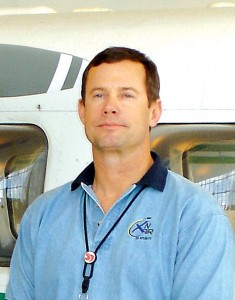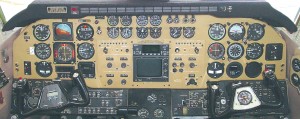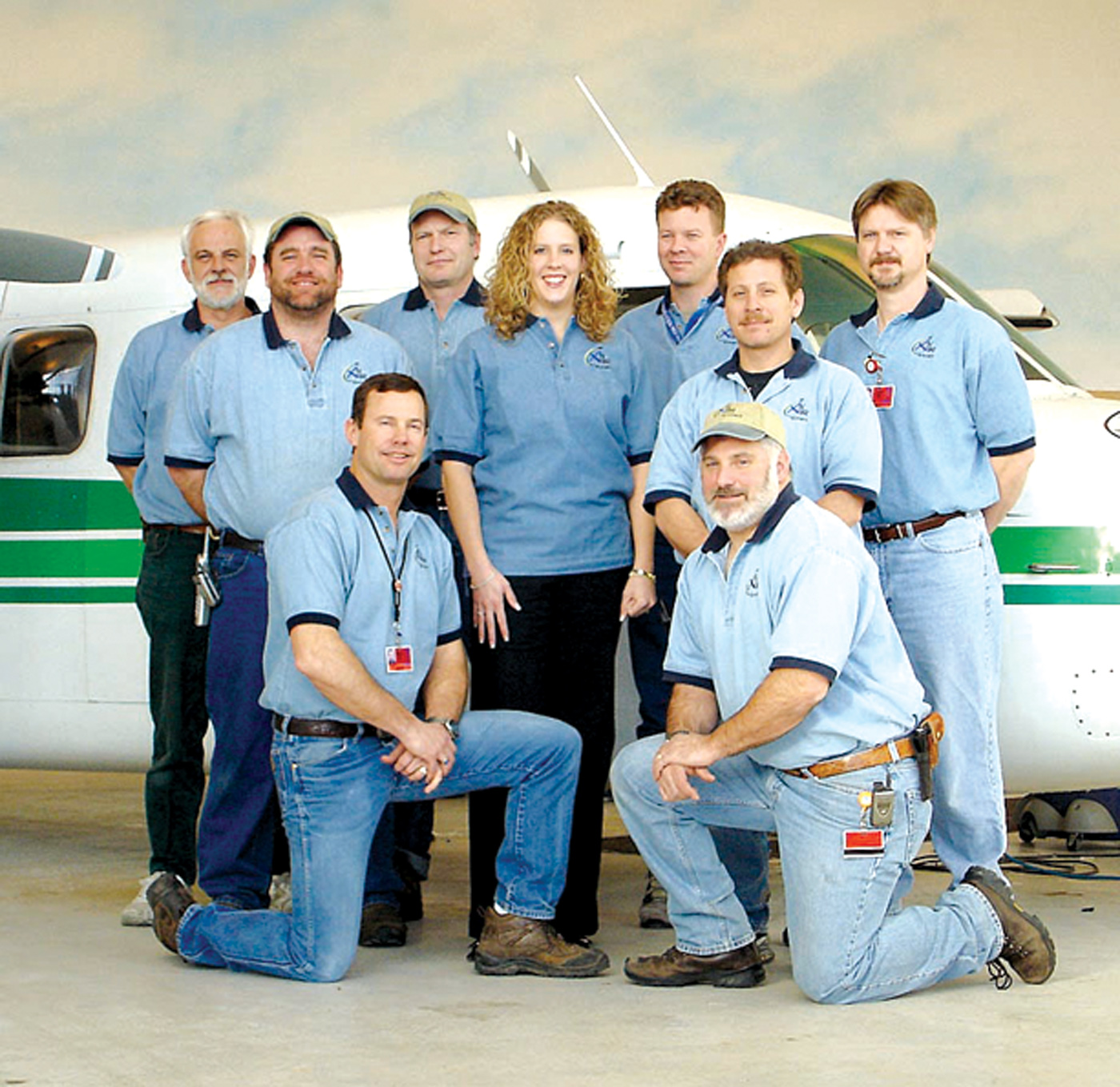By Terry Stephens

Installation experts at XN Avionics in Spokane include, L to R: (standing) Axel Armbruster, Vaughn Burgess, Phil Carlson, Kristi Harvie, Jeff Pugh, Scott Manina and Robert Maahs, with (kneeling) John Hale and Jeff Hartley.
The rapid growth of a new avionics installation company, XN Avionics LLC, has spurred new construction at Spokane International Airport and even sparked thoughts of creating a core of new aerospace services at the airfield.
Only 18 months old and already cramped for workspace, XN Avionics will soon move into vastly expanded facilities and offices in a $1.6 million, 16,000-square-foot maintenance hangar the airport is building to lease to the firm. Also branded as XN Air, the company’s workforce of eight is expected to grow by another 55 employees over the next three years.
The avionics company, which installs and repairs aircraft communication and cockpit navigation equipment in planes ranging from single-engine Cessnas to Citation business jets, is a subsidiary of XN Technologies of Cheney, Wash., a community about 15 miles from the airport site. The parent firm, a manufacturer of high-performance electronic signal-processing equipment for 15 years, is owned by President Alan Hale and his son, John, who also is president of XN Avionics.
“This all began because my father and I own multiple aircraft between us, and we had a hard time finding good avionics support,” John Hale said. “We had an opportunity to buy Tri-City Avionics Inc., since the owner was retiring, and we built this XN Avionics around that.”
One of the Hales’ first moves was to begin extending their new company’s operations far beyond services Tri-City had offered, with XN Technologies providing much of the technical expertise to move into the aircraft avionics field. Now the only avionics company at Spokane International Airport, and one of only three in the Spokane-Coeur d’Alene area, XN Avionics installs radios, altimeters, autopilots and global positioning systems in a variety of aircraft, including complete conversions to “glass” cockpits.
The company soon began reaching beyond single-engine aircraft modifications to include business jets, knowing, too, that the Federal Aviation Administration’s new requirements for more sophisticated altimeter systems for high-altitude flying would lead to more work in the corporate area. The reduced vertical separation minimum regulations reduce the minimum vertical spacing between aircraft from 2,000 to only 1,000 feet for altitudes between 29,000 and 41,000 feet, doubling the number of air routes in that fuel-efficient air zone. The change is expected to save airlines more than $5 billion in fuel costs over the coming decade.
As a result, business jets, as well as airliners flying at those altitudes, are required to install the more precise altimeters and autopilots that made the FAA changes possible. The new equipment is accurate to within less than 200 feet in that zone. Hale said cockpit modernizations for private planes are expensive, costing $60,000 to $70,000, “on the low end.”

John Hale is president of XN Avionics, also known as XN Air, a rapidly growing new aerospace company at Spokane International Airport.
Even without that future work, Hale said, the firm is already growing. Starting with five employees, more than Tri-City had on staff, the company is at eight and growing. Presently its work is limited only by available hangar space.
“We could be doing more work right now if we had room for the additional planes,” Hale said.
XN Avionics is rapidly carving its own niche in the avionics market, offering custom design and engineering capabilities; IFR/VFR certifications; and maintenance on all brands of avionics systems, including Garmin, Chelton and Honeywell—with lifetime warranties on all installations.
“We attract business because we’re more than just installers. We’re pilots, too, and we deal with our customers from that perspective,” said Hale, noting that the facility is also an FAA certified repair station and sells many of the brands of equipment it installs. “With new technologies coming out, we’re working hard to be a leader in installing those technologies. One of the most promising that’s getting a lot of focus is Chelton’s new flight information system that creates a glass cockpit in older planes.”
Another niche Hale has been developing is working closely with builders of kit aircraft who want new flight instrument technology. The pilots want to build an airplane but “when it comes to the avionics they’re lost,” said Hale, who also would like to establish a relationship with a kit manufacturer.
The firm’s growth and future plans soon caught the attention of airport officials, who secured one million dollars in state financing and $602,000 in airport matching funds to build a new maintenance hangar to lease to XN Avionics. The funds, approved by the Washington Department of Community, Trade and Economic Development, came from the state’s Community Economic Revitalization Board.
Still smarting from losing an airport cargo carrier tenant and 40 jobs when Empire Airlines left for Coeur d’Alene Airport, Spokane airport officials moved fast to help XN Avionics expand, since the avionics firm, too, was looking for more space.

This “before” view of an aircraft panel shows the usual instrument clutter traditionally found in most modern aircraft.
The 55 new jobs expected at XN Avionics will provide salaries averaging $37,000 annually, about $4,000 above Spokane County’s average wage. The project is expected to generate about $800,000 annually in state and local revenue through taxes, investment benefits and other economic impacts. Still in the design stage by Womer & Associates Inc. of Spokane, the contract should be awarded in May, with construction due to be finished by late August.
“We’ve come a long way in less than 18 months in business,” said John Hale. “We had three Citations in today and two of them rolled out. Plus, we work closely with the FBO here, Spokane Airways, and get a lot of business off the flight line when local or visiting planes have technical problems.”
The growth of XN Avionics is also a potential catalyst for creating more aviation, technical and manufacturing businesses and jobs at the airport, said Todd Woodard, the airport’s director of marketing and public relations.
“Twenty-five percent of the new hangar will be set aside for research and development of new aviation products that could be manufactured at the firm’s Cheney plant. There are a lot of synergies. We feel it’s a very good project,” Woodard said. “We’re doing well as an airport but we’re also working with the chamber of commerce and economic development council to develop more of an aerospace cluster of companies engaged in parts, service or aircraft.”
As part of upgrading the airport to attract more businesses, the board is investing $80 million between 2003 and 2006 in projects that include a $6 million airport tech park, a 3,000-foot extension of Runway 3/21 for $8 million, expanded taxiways, a new $248,000 fuel dispensing facility and a $4 million general aviation apron construction.
For more information, call (509) 455-5204 or (866) 755-5204, or visit [http://www.xnair.com].











